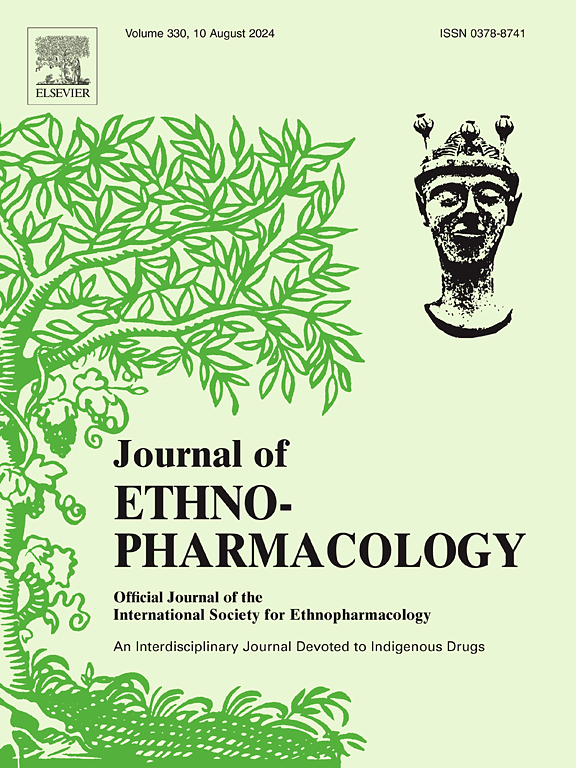网络药理学指导下治疗急性咽炎蓝芩口服液等效组合成分的鉴定。
IF 4.8
2区 医学
Q1 CHEMISTRY, MEDICINAL
引用次数: 0
摘要
民族药理学相关性:兰芩口服液是临床治疗急性咽炎疗效较好的纯中药制剂。但其有效成分和作用机制有待进一步研究。研究目的:本研究采用网络药理学方法,揭示了LQL的生物活性等效组合成分(BECCs),并探讨其治疗急性咽炎的机制。材料与方法:本研究通过网络药理学构建LQL与咽炎相关的C-D-T (component-disease-target, C-D-T)网络,根据C-D-T网络中各节点的度值寻找候选BECCs。通过动物实验和细胞实验评价BECCs和LQL抗急性咽炎的作用,验证网络药理学预测的重要信号通路。此外,通过联合指数(CI)法进一步探讨BECCs核心活性成分小檗碱(berberine, BBR)和京尼平苷(geniposide, GE)的协同作用。结果:网络药理学结果显示,龙参中有25种潜在有效成分和35个靶点参与了急性咽炎的治疗,覆盖了20条信号通路。基于网络药理学度值,13个化合物被鉴定为BECCs。体外和体内研究显示,BECCs在治疗急性咽炎方面表现出与LQL相当的疗效。BECCs可通过减少NO的释放、炎症因子(IL-6、IL-1β、TNF-α)的分泌以及相关蛋白(TLR4、p-p65)的表达来治疗急性咽炎。值得注意的是,BBR和GE是BECCs中最有效的成分,显示出显著的抗炎协同作用。结论:LQL的BECCs对急性咽炎的治疗效果与原方相当,可能通过调节TLR4/NF-κB信号通路发挥抗炎作用。BECCs中的不同成分可能表现出协同的药理作用。这些发现为LQL的临床应用提供了坚实的科学依据。本文章由计算机程序翻译,如有差异,请以英文原文为准。
Network pharmacology-guided identification of bioactive equivalent combinatorial components in Lanqin Oral Liquid for acute pharyngitis treatment
Ethnopharmacological relevance
Lanqin Oral Liquid (LQL) is a pure herbal preparation with a good therapeutic effect on acute pharyngitis in clinic. However, its active ingredients and action mechanisms need further research.
Aims of the study
This work employed network pharmacology to uncover the bioactive equivalent combinatorial components (BECCs) of LQL and investigate their mechanisms in treating acute pharyngitis.
Materials and methods
In this study, a component-disease-target (C-D-T) network related to LQL and pharyngitis was constructed through network pharmacology and candidate BECCs were found based on the degree values of each node in the C-D-T network. The anti-acute pharyngitis effects between BECCs and LQL were evaluated by animal and cell experiments, and the vital signaling pathways predicted by network pharmacology were verified. Additionally, the synergistic effect of berberine (BBR) and geniposide (GE), the core active ingredients of BECCs, was further explored by the combination index (CI) method.
Results
Network pharmacology indicated that 25 potential active ingredients in LQL and 35 targets were involved in the treatment of acute pharyngitis, covering 20 signaling pathways. Based on network pharmacology degree values, 13 compounds were identified as BECCs. In vitro and in vivo studies revealed that BECCs exhibit comparable therapeutic efficacy to LQL in treating acute pharyngitis. BECCs could treat acute pharyngitis by reducing the release of NO, secretion of inflammatory factors (IL-6, IL-1β, and TNF-α), and expression of related proteins (TLR4 and p-p65). Notably, BBR and GE emerged as BECCs' most effective components, demonstrating significant anti-inflammatory synergy.
Conclusion
BECCs of LQL demonstrate comparable efficacy against acute pharyngitis to the original formula, which may exert anti-inflammatory effects by regulating the TLR4/NF-κB signaling pathway. The diverse components in BECCs potentially exhibit synergistic pharmacological effects. These findings provide a solid scientific foundation for the clinical application of LQL.
求助全文
通过发布文献求助,成功后即可免费获取论文全文。
去求助
来源期刊

Journal of ethnopharmacology
医学-全科医学与补充医学
CiteScore
10.30
自引率
5.60%
发文量
967
审稿时长
77 days
期刊介绍:
The Journal of Ethnopharmacology is dedicated to the exchange of information and understandings about people''s use of plants, fungi, animals, microorganisms and minerals and their biological and pharmacological effects based on the principles established through international conventions. Early people confronted with illness and disease, discovered a wealth of useful therapeutic agents in the plant and animal kingdoms. The empirical knowledge of these medicinal substances and their toxic potential was passed on by oral tradition and sometimes recorded in herbals and other texts on materia medica. Many valuable drugs of today (e.g., atropine, ephedrine, tubocurarine, digoxin, reserpine) came into use through the study of indigenous remedies. Chemists continue to use plant-derived drugs (e.g., morphine, taxol, physostigmine, quinidine, emetine) as prototypes in their attempts to develop more effective and less toxic medicinals.
 求助内容:
求助内容: 应助结果提醒方式:
应助结果提醒方式:


